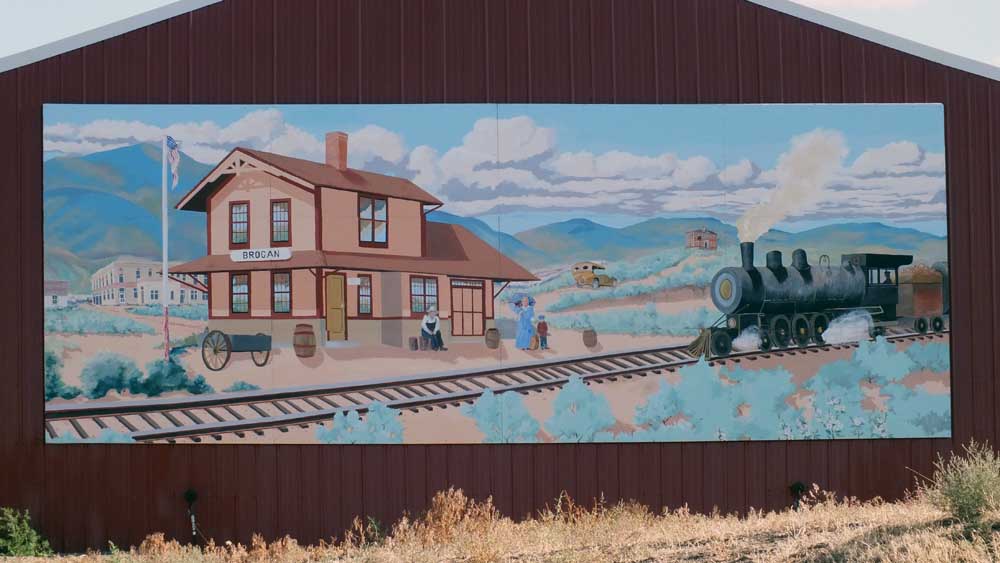|
Union Pacific Oregon Eastern/Burns Branch Brogan Branch |
|
|
|
|

|
|
The rising waters of Malheur Lake eventually inundated 15 miles of the Burns branch between Crane and
Burns. The speeder is sitting at the eastern end of the damaged track
at Milepost 131.2, near the old station site of Albritton and approximately
five miles west of Crane, on 24 May 1986. Tom Moungovan photo, courtesy of Wayne Monger. The failure of Harriman's Cross State Railroad project in 1913 found the end of UP's portion of the proposed line in the Malheur River canyon west of Vale, OR. Despite the setback, construction continued westward, with Juntura reached by 1914 and Crane reached in 1916. The completion of the line to Crane marked the beginning of several decades of litigation in which the State of Oregon attempted to force the UP to expand its eastern Oregon network so that the central portion of the state could be opened up to settlement and development. The efforts of the state led to the Interstate Commerce Commission issuing an order in 1930 instructing the UP to build a new line from Crane to a connection with the Southern Pacific somewhere in the Eugene area. The Great Depression made constructing this route economically unrealistic, and the ICC withdrew the order in 1933. The State of Oregon then went to the courts in an attempt to force the ICC te re-issue the order, but the Supreme Court ruled in favor of UP and the ICC in 1935. The only further expansion of the UP into central Oregon came in 1924 following the acquisition of the Malheur Railroad. One branchline running 23.3 miles from Vale northwest to Brogan was built off of the Burns branch. This line was completed in 1910. The line survived primarily on agricultural traffic. The 5.2 miles at the end of the line, from Jamieson to Brogan, was officially abandoned in 1964; the balance of the line survived on sugar beet traffic until 1979, when the beet traffic shifted to trucks and the line was abandoned.  A mural in Brogan depicting the Union Pacific in town. Jeff Moore photo. The Burns branch moved predominately agricultural traffic until 1930, when the huge Edward Hines Lumber Company sawmill in Burns commenced operations. Forest products then became the principle traffic moved over the line, although agricultural traffic remained important through the 1950s, when it shifted to trucks. Service over the line through the 1950s was provided by a mixed train, Train Numbers 459 and 460, that made the 157-mile trip between Ontario and Burns in eight hours. Traffic handled out of Burns went into a steep decline at the dawn of the 1980s. 1979 saw 4,955 outbound and 89 inbound loads handled to or from Burns. By 1980 this figure was down to 2,336; 1981 saw 848 loads, and the first three months of 1982 saw 221 loads. UP closed the Burns depot in mid-1982, with the switching and weighing of cars in Burns contracted out to the Oregon & Northwestern Railroad. The agency functions formerly handled in Burns was transferred to the depot in Ontario. A good portion of the 30 mile stretch between Crane and Burns was built along the shores of Malheur Lake, and up until the early 1980s the lake had given the railroad very little trouble. A series of wet winters caused the water level to start rising, and by the early months of 1984 the railroad grade was threatened. Rumors started circulating that UP planned to abandon the line to Burns, but these rumors were denied by UP. However, the rising lake levels continued to inch closer to the tracks, and UP notified all shippers in Burns that it would cease operations once the water reached the level of the ties. Trains operating in late February reported water over the tracks in a couple locations, and on 8 March 1984 a UP crew gathered up everything that could be moved and headed east, leaving Burns without rail service. Those cars that could not be taken out in the last train were either cut up for scrap or trucked out to Crane, which once again became the new end of track. UP announced that it would re-build the trackage and resume service to Burns once the waters receded, but after the lake levels dropped no efforts were made to repair the flood damage. Some local and state politicians talked about forcing UP to resume service, but no actions were taken. UP finally decided to divest itself of the line, and in 1986 the entire Burns branch was placed on the list of branchlines available for sale or lease. A deal was initially struck with Intermountain Western Industries of Boise, ID, that would have seen the Burns branch conveyed to the new Intermountain Western Railroad along with a package of other branchlines in eastern Oregon and southern Idaho. The Intermountain Western purchased and painted a few locomotives and did some other work necessary to start operations, but the deal fell apart at the last minute. One of the principles behind the Intermountain Western was Western Railroad Builders of Ogden, Utah. WRB was interested in the Burns branch, and after Intermountain Western deal fell through the company negotiated with UP to purchase the line. A contract to buy the line was signed in the early part of 1989, and the Interstate Commerce Commission approved the sale on 13 April 1989. Technicalities and legal delays prevented the sale from going through for a number of months, and WRB finally took possession of the line and commenced operations on 6 November 1989. The new company was known as the Oregon Eastern Division of the Wyoming/Colorado Railroad. Click on the link; the page on that operation will open in a new window. |
|
|
Map |
|
|